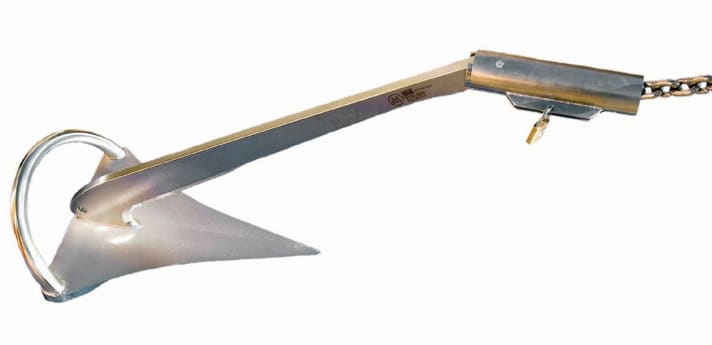
The number of boat and accessory thefts has remained at a high level for years. In addition to complete boats and outboards, high-value equipment and accessories are also increasingly being targeted by crooks. Why? Firstly, access to the inside of the boat is usually inadequately protected and secondly, equipment parts are usually easy to dismantle, not individually marked and can therefore be sold quickly on the relevant platforms. However, the security industry has also recognised this trend and offers appropriate countermeasures via the trade. We have taken a closer look at some of the new prevention options as well as the classic solutions and show below how and with what you can protect your belongings. Particular attention should be paid to new electronic solutions. GSM cameras, GPS trackers and immobilisers cannot completely prevent theft, but in addition to deterring theft, they also make it much easier for the police to investigate. What thief would want to be filmed in real time, contacted via a mobile phone network, localised and tracked on an interactive map? Seen in this light, there are justified hopes that modern technology will make life more difficult for potential thieves and allow boat people to sleep more soundly.
Tip from the editors
-Hatch contacts trigger an alarm, just as attempts are made to open hatches or windows by force from the outside. They can also be integrated into alarm systems.
-Safe Small safes are primarily intended for the secure storage of cash, papers, jewellery or watches. They are available from specialist retailers and are concealed in the boat or even laminated in.
-Cameras are available in many different versions. Either permanently installed with a memory chip, with corresponding motion sensors or as a GSM version, in which they transmit the images (including video) in real time via the mobile phone network to the boat owner's phone. The advantage of this technology is that you can take a look at your own boat at any time without having to go to the harbour all the time. Very useful when the boat is far away.
-Localisation systems store the position of the boat at certain intervals and can transmit this to the owner in the event of an alarm. Many stolen boats have already been found in this way.
-Immobilisers are commonplace in cars today. On a boat, they can be retrofitted relatively easily. Manufacturers can provide tips on retrofitting old engines.
-Hidden main switch are a classic but still sensible measure. No boat can be started and stolen without electricity.
-Safety eyelets are useful for dinghies and outboards. Although they and the associated chains can generally be cracked, they are a deterrent and delay the theft considerably.
-Door contacts They can be easily retrofitted and, in combination with alarm systems, attract a lot of attention.
-Key switch are also concealed and can be used for various functions such as activating the alarm system, interrupting the fuel supply or disconnecting the ignition voltage.
Insurance as a sticking point
A third-party liability policy is of no use in the event of theft. Comprehensive insurance usually does. What you need to bear in mind
Almost everyone has liability insurance for their boat - and that's a good thing. Anyone who culpably causes damage to others with their boat is liable with their total assets. An incalculable risk. The situation is different with a boat including engine/engine and, if applicable, dinghy, equipment, inventory and trailer. Here, the maximum value at stake is fairly clear. If you want to protect yourself here too, take out yacht hull insurance with all-risk cover for the aforementioned items, where everything that is not expressly excluded is deemed to be insured. Thoroughly reading the insurance conditions is therefore a must if you don't want to experience another nasty surprise after a theft shock. As different as the hull conditions of the insurance companies are, they are similar when it comes to the exclusions relating to theft. For example, the insurance company will not pay compensation for the stolen boat and trailer if the trailer was not secured with "suitable" or "standard" devices. The same applies to the theft of outboard motors. You should clarify what this means in detail with your insurance company beforehand and have it confirmed in writing. Another tip for fulfilling your obligations: Use photos and data to create as detailed a documentation of your boat as possible, including the engine, equipment, inventory and trailer, so that you can quickly provide information relevant to the investigation in the event of theft and clear identification features in the event of recovery. The boat passport issued by the GDV and the police is recommended for data maintenance: www.polizei-beratung.de/medienangebot/detail/105-bootspass/
Special locks

Anchor lock: It is safe on the ground, but a favourite object of theft on the bow. Especially in stainless steel versions worth up to 1500 euros. A lock around the connector between the chain and anchor (approx. 135 euros, swi-tec.de) makes it difficult for thieves.

Hatch lock: If all hatches are closed when you leave the boat, it will be stuffy and warm when you return. With hatch locks (approx. 320 to 395 euros, swi-tec.de), however, they can remain open.

Door lock: Locks installed by the shipyards are often easy to pick. With a retrofitted burglar alarm de luxe, thieves face a real obstacle (approx. 235 euros, swi-tec.de).
Accessory lock

Decklock: The dinghy, the SUP board, the life raft ... Everything that lies loose on deck is easy to take with you. The Decklock from Stazo (approx. 180 euros, e.g. at awn.de) can therefore be conveniently fastened to a bracket mounted on the deck using the steel cable supplied.
Motorised locks

Outboard motor screw lock: Motors are a favourite target for thieves. With the lock from Stazo Nutlock (approx. 90 euros, e.g. at svb.de), engines from 35/40 hp can be effectively protected.

Toggle bolt lock: Smaller outboards up to 35/40 hp can be secured against theft with the Stazo Smartlock (approx. 100 euros, e.g. shop.gruendl.de).
Deck eye

U-bolts: Chaining is good - but what if there is no stable holding point for the lock and chain? Such U-bolts from Wichard (approx. 15-30 euros, e.g. at Amazon ) are self-sealing and give thieves no chance.
Safe

A safe place: You don't always want to take your passport, credit cards, hard drives or other important items with you when you go ashore. That's why it's a good feeling if you can store them safely in such a safe (approx. 35 euros, e.g. at Amazon ) are stored.
Propeller lock

Safety nut: Propellers are expensive, but can usually be dismantled quickly. The propeller safety nut from McGard (approx. 95 euros, lindemann-kg.de) is made of corrosion-resistant material and can be easily replaced with the old nut. Instead of opening, a loose sleeve rotates.
Hose insert

Fuel theft: One piece of hose, one suck - and the expensive fuel flows into the thief's canister. To prevent the hose from getting into the tank, however, there is the yellow hose insert from Vetus (from approx. 12 euros, e.g. yachtzubehoer24.eu).
Trailer securing

Use: This lock (from approx. 12 euros, various internet shops) is inserted into the coupling mouth of the trailer drawbar so that no thief can tow the boat trailer away.

Box lock: A box lock has a more deterrent effect (from 20 euros, e.g. at Amazon ), which is slid over the ball coupling and secured with a disc lock. The lock is difficult to break open because the locking bracket is almost impossible to reach with bolt cutters or an angle grinder.

Wheel claw: If the wheel cannot be turned, the trailer cannot drive. Such wheel claws (from approx. 30 euros, e.g. at Amazon ) also prevent the wheel from being dismantled.

Hermaphrodite: The mixture of an enclosing and inserted lock (approx. 17 euros) also provides good protection.
Defence against criminals using modern technology
If fittings and locks are not a sufficient obstacle, monitoring and alarm systems will alert you to the break-in
Alarm systems

Alarm system and tracker: The GeoSafe (basic kit: approx. 140 euros, e.g. at Amazon ) alerts you and up to five other people by text message if the boat is broken into, is more than 200 metres away from the mooring or if one of the optional magnetic contacts or sensors is triggered.

Door wedge: Such a wedge (approx. 10 euros, e.g. at Amazon ) blocks a door from the inside and at the same time draws attention to itself with a 110 dB loud signal tone.

Alarm system and tracker: The Thitronik WiPro III (approx. 320 euros, e.g. at Amazon ) can be modularly extended with various sensors and modules, such as a gas sensor.

Window alarm: The sensor (approx. 10 euros, e.g. at Amazon ) can be mounted on the hatch and sounds an alarm at 120 dB.
Immobiliser

Off the shelf: If an engine with Mercury's anti-theft device (TDS) is started without the electronic key, the engine power is severely limited.

DIY solution: Such a hidden ignition interrupter (approx. 45 euros, Internet) can only be activated with the corresponding remote control.
Camera systems

GSM camera: Equipped with a GSM module (mobile phone network), WLAN and motion sensor, the camera (see BOOTE 6/18) transmits live images directly to the boat owner's mobile phone (e.g. available at Amazon )

WLAN camera: It transmits the image directly to the boat's own WLAN or to an internal memory. Also works as a manoeuvring aid with a screen in the driving position.
Mobile alarm device

Innovation: The Spexor alarm system from Bosch takes a completely new approach to monitoring, which can be put into operation without any major installation. The size of a can of cola, it can be set up inconspicuously on board and immediately monitors the surroundings with a large number of sensors. The system recognises a break-in by evaluating a combination of pressure, noise and motion sensors. Spexor then reports the changes to the user via an acoustic and/or silent alarm using a smartphone app. Thanks to the built-in lithium-ion battery and an eSim, Spexor can be operated for two to three weeks without mains power and without WLAN via the mobile phone network. An ideal solution for boaters. Spexor costs around 240 euros and is available from various retailers on the Internet, such as at Cyberport .
Tracker

Low budget: The tracker from TKMARS (approx. 55 euros) offers up to 90 days operating time with the built-in battery and a waterproof housing, available at Amazon ).

Professional: The tracker from Connect it Boat (approx. 320 euros, e.g. ferropilot.de) offers more monitoring options (including boat technology).
In some of our websites we use so-called affiliate links. These are marked with an asterisk (*). If you click on such an affiliate link and make a purchase via this link, we receive a commission from the online shop or provider concerned (e.g. Amazon). This does not change the price for you.

